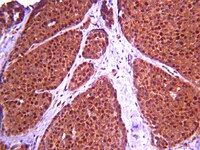Extracellular SOD-derived H2O2 promotes VEGF signaling in caveolae/lipid rafts and post-ischemic angiogenesis in mice.
Jin Oshikawa,Norifumi Urao,Ha Won Kim,Nihal Kaplan,Masooma Razvi,Ronald McKinney,Leslie B Poole,Tohru Fukai,Masuko Ushio-Fukai
PloS one
5
2010
概要を表示する
Reactive oxygen species (ROS), in particular, H(2)O(2), is essential for full activation of VEGF receptor2 (VEGFR2) signaling involved in endothelial cell (EC) proliferation and migration. Extracellular superoxide dismutase (ecSOD) is a major secreted extracellular enzyme that catalyzes the dismutation of superoxide to H(2)O(2), and anchors to EC surface through heparin-binding domain (HBD). Mice lacking ecSOD show impaired postnatal angiogenesis. However, it is unknown whether ecSOD-derived H(2)O(2) regulates VEGF signaling. Here we show that gene transfer of ecSOD, but not ecSOD lacking HBD (ecSOD-DeltaHBD), increases H(2)O(2) levels in adductor muscle of mice, and promotes angiogenesis after hindlimb ischemia. Mice lacking ecSOD show reduction of H(2)O(2) in non-ischemic and ischemic limbs. In vitro, overexpression of ecSOD, but not ecSOD-DeltaHBD, in cultured medium in ECs enhances VEGF-induced tyrosine phosphorylation of VEGFR2 (VEGFR2-pY), which is prevented by short-term pretreatment with catalase that scavenges extracellular H(2)O(2). Either exogenous H(2)O(2) (>500 microM), which is diffusible, or nitric oxide donor has no effect on VEGF-induced VEGFR2-pY. These suggest that ecSOD binding to ECs via HBD is required for localized generation of extracellular H(2)O(2) to regulate VEGFR2-pY. Mechanistically, VEGF-induced VEGFR2-pY in caveolae/lipid rafts, but non-lipid rafts, is enhanced by ecSOD, which localizes at lipid rafts via HBD. One of the targets of ROS is protein tyrosine phosphatases (PTPs). ecSOD induces oxidation and inactivation of both PTP1B and DEP1, which negatively regulates VEGFR2-pY, in caveolae/lipid rafts, but not non-lipid rafts. Disruption of caveolae/lipid rafts, or PTPs inhibitor orthovanadate, or siRNAs for PTP1B and DEP1 enhances VEGF-induced VEGFR2-pY, which prevents ecSOD-induced effect. Functionally, ecSOD promotes VEGF-stimulated EC migration and proliferation. In summary, extracellular H(2)O(2) generated by ecSOD localized at caveolae/lipid rafts via HBD promotes VEGFR2 signaling via oxidative inactivation of PTPs in these microdomains. Thus, ecSOD is a potential therapeutic target for angiogenesis-dependent cardiovascular diseases. 記事全文 | 20422004
 |
Residue depletion of doramectin in rabbit tissues after subcutaneous administration.
Jianzhong Shen,Na Li,Haiyang Jiang,Jiancheng Li,Qinxiong Rao,Liming Guo,Weimin Shi,Shuangyang Ding
Journal of food protection
72
2009
概要を表示する
A sensitive and reliable method was developed for the detection of doramectin (DRM) in rabbit tissues (muscle, liver, kidney, and fat) by high-performance liquid chromatography with fluorescence detection. The limit of detection and the limit of quantification were 0.36 ng.g(-1) and 1 ng.g(-1), respectively, for all four tissues examined. Mean recoveries ranged from 70.8 to 98.0% for all samples at all fortification levels with a coefficient of variation below 12.1%. The method was further applied to study depletion of DRM residues in rabbits subcutaneously administered a single dose of 0.4 mg.kg(-1) body weight. The highest DRM concentration was measured in fat tissue, indicating that fat is the target tissue for DRM in rabbits. Although the concentrations of DRM residues in all tissues were below the maximum residue limits established by the European Medicines Agency, the Codex Alimentarius Commission, and the Ministry of Agriculture of China for other food-producing species at 16 days posttreatment, the statistically established withdrawal period was calculated to be 23 days. | 19833044
 |














